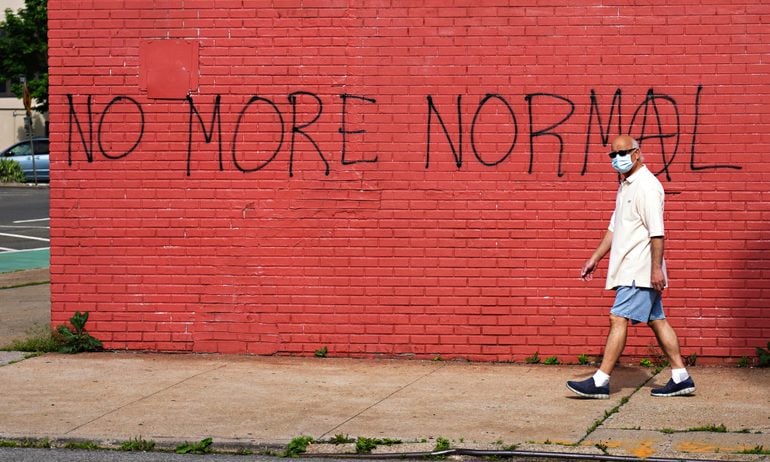Pandemic at 3 Years: How Our Financial Lives Have Changed
Since COVID-19 came into our lives, a lot has changed, including the way we work, travel, save and spend.

Many, or all, of the products featured on this page are from our advertising partners who compensate us when you take certain actions on our website or click to take an action on their website. However, this does not influence our evaluations. Our opinions are our own. Here is a list of our partners and here's how we make money.
Table of Contents
When the COVID-19 pandemic first hit, most of us had little clue just how much everything was about to change.
In early March 2020, the World Health Organization and the U.S. government declared a health emergency. Within days, masks, toilet paper and disinfectants were in short supply. Businesses emptied out as former office dwellers traded in commutes and desk jobs for sweatpants and video conferencing.
Meanwhile, workers in grocery stores, public transit, trucking and janitorial positions found themselves on the “front line” of a war they never volunteered for. Students lost time in school while teachers and parents burned out at home. Those in the medical field faced dwindling supplies, exhaustion, trauma and illness while treating sick patients.
In the days, months and years since those initial lockdowns, millions of people fell ill with COVID. Most recovered, but Centers for Disease Control data show more than a million and counting lost their lives in the U.S., and almost 7 million globally. With medical interventions and the development of vaccines, we slowly learned to live with the virus, establishing a “new normal.”
Come May, the White House is expected to end its pandemic emergency. But COVID-19 still lurks in ever-shifting form, and some of the societal changes it spawned are likely here to stay. Here are just some of the ways the pandemic has altered how we work, spend, save, travel and live.
It changed the way we work
Office workers don't want to go back. As offices shuttered, employers figured out all their employees needed was an internet connection and a laptop to keep their businesses running.
City centers that were once bustling with commuters looked like ghost towns. From 2019 to 2021, the share of people working from home tripled, according to the Census Bureau’s American Community Survey. The data also showed the lowest percentage of workers commuting by public transportation ever. Postings for remote positions increased 457% from 2020 to 2021, according to LinkedIn data.

What was once a unicorn job perk had become the norm — at least for a little while. As lockdown restrictions lifted, some employers shuttered offices for good, while others began pulling employees back full-time or adopted a hybrid model.
Still, there are still more job seekers looking for remote work than employers will supply, according to October 2022 data from LinkedIn. It’s unclear who will win, but with unemployment at record lows, employers may need to bend to worker demand for flexibility.
It’s never been a better time to switch jobs. Countrywide shutdowns prompted unprecedented unemployment, which peaked at 14.7% in April 2020, according to Bureau of Labor Statistics data — the highest level it had ever reached since the U.S. began tracking.
As the nation began the arduous process of reopening over the next couple of years, employers had difficulty finding workers to fill spots, with the biggest challenges in the hospitality sector, Bureau of Labor Statistics data shows. Suddenly there were more than enough jobs to go around and that trend has persisted.
Today federal data shows unemployment is at a more than 50-year low. Meanwhile, quit rates have remained steady — a sign that workers feel safe switching jobs.
Women dropped out of the workforce, then made a comeback. As of the fourth quarter of 2022, 54.6% of women ages 16 and older were employed as compared with 55.7% in the same quarter of 2019 before the pandemic began, according to the Bureau of Labor Statistics. The percentage of women in the workforce dropped to its lowest point, 47.5%, in the second quarter of 2020. Even with rebounding employment, a gender gap lingers in the latest figures: Women lag roughly 11 points behind their male counterparts.
While not employed, women lost out on income, retirement savings and other crucial benefits that affected their personal finances. But, as they have reentered workplaces, women — especially those with young children — have benefited from a strong labor market, the reopening of schools and child care facilities, and vaccine availability.
Workers retired early, then some un-retired. At the start of the pandemic, millions of U.S. workers were either homebound for the foreseeable future or forced to continue their jobs in challenging conditions. Many of those workers who were already nearing retirement decided to pull the trigger, leading to a boom in retirees — but not all of them remained out of the workforce for long.
By August 2021, an estimated 2.4 million workers had retired early or unexpectedly since the pandemic began, according to research from the Federal Reserve Bank of St. Louis. People retired for myriad reasons: Some workers had been able to shore up their savings during the pandemic and were able to stop working, while others simply fast-forwarded a decision they’d been planning to make in the next few years. Some opted to bow out instead of returning to unsafe or risky work conditions.
Retirement didn't last long for some. Among those who retired during the pandemic, 27% of people returned to work because they simply needed a bigger nest egg to get them through their golden years, according to a report from Joblist, an employment listings and research site; 21% said they specifically returned to the workforce in response to inflation and the rising cost of goods.
We stopped going places (for a while)
Travel tanked, then the world reopened and demand shot up. Airfares and hotel prices tanked in spring 2020 as folks paused travel. Travel sector workers lost jobs, revenues declined and some destinations shuttered completely, including Disneyland, which remained closed for 412 days.
Upon reopening, experiences changed. Hotels and airlines emphasized cleaning. Rewards programs extended elite status. Formerly strict cancellation policies eased. Prices stayed low throughout 2021.

But in 2022, travel roared back. By May 2022, travel prices hit record highs given inflation plus surging demand, according to Bureau of Labor Statistics data.
While costs have eased, they’re still higher than before the pandemic, consumer price index data show. But that’s not stopping travelers, as many tourism destinations reported record visitors in 2022 — and experts are predicting more travel records being broken in 2023, according to the Transportation Security Administration.
Credit cards adapted to a stay-at-home world as we turned to home projects, kitchen experiments and TV binges. Incentives were added or expanded to include online shopping, home improvement, streaming services or grocery deliveries. Dining rewards on credit cards specified takeout and delivery purchases as eligible. And, travel credit cards added nontravel options for earning and redeeming points.
Prices went up …
Everything got more expensive. Consumers armed with fatter paychecks and bolstered savings shopped for goods and renovated their homes. When lockdowns were lifted and travel reopened, they spent on restaurants, airline tickets and other services.
Global supply chain disruptions had trouble keeping up with demand, which led to higher prices for goods and services. Supply chains were snarled further by the war in Ukraine, beginning in February 2022, particularly when it came to energy prices.

Oil and fuel prices jumped worldwide, leading to peak high prices in June 2022. Oh, and all along there’s been an ongoing avian flu blowing up the price of eggs and poultry.
Inflation peaked at 9.1% in June 2022 — the highest rate in 40 years, according to Bureau of Labor Statistics data.
But that high didn’t persist for long. Slowly but surely, the inflation rate inched lower, and according to the most recent consumer price index (a proxy for inflation) the annual rate is now at 6.4%.
The car market turned upside down. Supply chain problems caused new car production to plummet, pushing more car shoppers to buy used vehicles. Because of sparse dealer inventory, car buyers ordered directly from manufacturers or shopped online. Vehicle shortages drove prices to historical highs. Three years later, the average new car price remains at nearly $50,000, and $26,000 for used, according to data company Cox Automotive.
While vehicle inventory is improving, car buyers now face auto loan interest rates at a 20-year high. In an attempt to find the best deal, more car buyers expect at least part of their car shopping and financing journey to be online.
… so the Fed raised interest rates
Rates were raised. And raised again. And again. As inflation ballooned, the Federal Reserve began to take action in one of the only ways it could, by raising the federal funds rate. The intent behind raising interest rates is to increase the price of credit, which makes it more expensive for consumers to borrow money. As spending declines, demand lowers and prices deflate.
In September, Federal Reserve Chair Jerome Powell remarked that there was no “painless way” to lower inflation, and he meant it. The Fed raised the funds rate a whopping seven times in 2022 and once so far in 2023.
Inflation has started declining, with the current rate at 6.4%. But the Fed has a 2% target, so additional hikes are likely.
It changed the way we bought homes
The market was hot, then not so much. Spring 2020 saw the U.S. housing market at a virtual standstill, as many states deemed home buying and selling a nonessential service. But stay-at-home orders had many Americans itching to move, especially as mortgage rates headed downward thanks to the Fed's emergency rate cut in March 2020.
As quarantines lifted and interest rates fell, investors and new buyers made big moves, even snapping up properties sight unseen. Many homeowners opted to refinance to historically low rates instead of putting their homes on the market. Competition for limited inventory heated up, and bidding wars, waived contingencies and cash offers became commonplace. Though mortgage interest rates went to record lows, skyrocketing home prices hammered affordability. Exhausted buyers began to experience burnout.

But it wasn't dropping demand, lack of inventory or high prices that finally turned down the heat on the housing market — it was the Federal Reserve. Mortgage interest rates that were already trending upward rose quickly once the Fed began hiking rates in March 2022. By October 2022, rates for 30-year fixed-rate home loans had shot to 7.08% — more than four percentage points higher than the low they hit in January 2021.
It changed the way we save
Savings bulked up, leveled off and declined. While stuck at home, consumers weren’t spending the way they used to, and those who qualified received an infusion of cash via government stimulus checks. Those factors, combined with higher wage growth, led to historic levels of personal savings. Households accumulated $2.3 trillion in savings from 2020 through summer 2021, Federal Reserve data show.
Then inflation started eating away at the gains households had made. The current savings rates are closer to where they were in March 2008, according to Bureau of Economic Analysis data. And a February report from Vanguard Group shows an increase in 401(k) account holders dipping into their retirement savings in 2022 to cope with financial challenges.
But there are signs that personal savings could come back again: The rate of personal savings began a steady incline after hitting a 2.7% low in June 2022.
Credit scores improved. People were allowed to self-report positive rent and utility payments and medical debt got wiped out. Overall, credit scores increased.
Decreased consumer spending early in the pandemic and emergency financial measures gave people more breathing room to pay off debts. Mortgages and student loans went into forbearance, rental assistance programs were put in place and the government issued three rounds of stimulus checks.

In April 2020, the three major credit bureaus, Equifax, Experian and TransUnion, made free credit reports available to consumers weekly instead of annually. Weekly credit reports from AnnualCreditReport.com remain free through 2023. The bureaus started removing paid medical collections from credit reports in July 2022 and will exclude medical debt in collections under $500 beginning in the first half of 2023.
Rates on savings accounts and CDs skyrocketed. The inflation partly caused by pandemic-related supply chain disruptions has led the Federal Reserve to increase its federal funds rate multiple times in the last year. Banks and credit unions took their cue to raise rates, particularly online banks, which compete with some of the highest yields. The best rates on savings accounts and CDs are above 4% annual percentage yields as of February 2023.
Banks merged and closed branch locations. From March 2020 to September 2022, the number of FDIC-insured banks dropped by 370, according to Federal Deposit Insurance Corp. data. This decline coincided with a record number of bank mergers in 2021, continuing a decades-long trend of consolidation within the banking industry. In addition, from 2020 to 2021, banks closed more than 2,700 branches. The pandemic accelerated a trend toward more digital banking and less reliance on in-person banking, though branches remain important for certain segments of the population, including many small-business owners.
And it changed the way we spend
"Buy now, pay later" exploded as more people started shopping online. These payment plans, which typically divide a purchase into four equal installments with zero interest, became available virtually everywhere thanks to popular providers like Afterpay, Affirm and Klarna.
But government watchdogs have their doubts. In September 2022, the Consumer Financial Protection Bureau released a report on BNPL and hinted at impending regulation, citing the ease of overspending and a lack of consumer protections as top concerns.
"Tip creep" may be here to stay. During the pandemic, an unexpected rule emerged: If you’re ordering food, using a delivery app or otherwise engaging with a frontline worker, tip generously. The generosity was well-deserved, as many low-paid retail and gig workers had to shirk stay-at-home orders because they were deemed "essential."
Fast-forward three years, and new tipping expectations might be here to stay. Scores of businesses use point-of-sale systems that prompt customers to tip, which has left consumers feeling anxious about whether or not they are expected to tip 20% on that to-go coffee. The new tipping etiquette is proving to be a boon for some employers, who can now rely on customers’ increased tips to help pay their workers the minimum wage.
Student loans became a political football
Borrowers are still in limbo. In March 2020, then-President Donald Trump froze federal student loan payments as an emergency pandemic measure. In the three years since, the White House has extended this pause — known as forbearance — no less than eight times. The reprieve is currently set to expire in the summer of 2023.

Meanwhile, the Supreme Court is evaluating the legal merits of President Joe Biden’s plan to cancel up to $20,000 in student debt per borrower. A final decision is expected by this summer. It’s unclear how the justices will rule, but it’s possible that borrowers will have to start repaying their student loans, with interest, without any cancellation.
Stocks went on a wild ride
Retail stock trading soared. In 2020, we were stuck at home, scrolling on our phones, wondering what to do with our stimulus checks during a period of historic market volatility.
Many of us downloaded a brokerage app and started trading stocks. One of these apps, Robinhood, saw an increase in accounts of more than 120% between the end of 2019 and the end of 2021. Larger, more established brokerages also saw increases. Schwab, for example, saw a 140% increase in accounts in 2020.
Many people bought meme stocks, companies with a dedicated social media following among investors. Shares of GameStop rose from less than $1 in April 2020, to more than $80 in January 2021.
That party didn’t last forever — GameStop shares are now below $20. But even though the growth in brokerage accounts slowed in 2022, it wasn’t reversed. So the meme stock craze may be over, but widespread retail trading appears to be here to stay.
The market had a two-year bull run. From the low of March 2020 to the high of December 2021, the S&P 500 index rose about 75%, led by tech companies.
But the rally didn’t last too far into 2022. High inflation prompted the Federal Reserve to start raising interest rates in March 2022, putting downward pressure on the stock market.
This, combined with supply disruptions due to the Russia-Ukraine war and fears about a looming recession, pushed the S&P 500 index down about 20% over the course of 2022. It has regained some ground in 2023, but it’s still too early to say whether the worst is over yet.
Telehealth got a boost
We couldn’t safely go into doctor’s offices, so doctors came to us.
More than 1 in 10 outpatient health care visits used telehealth in the first six months of the pandemic. Before, telehealth usage rates rounded to zero. By 2021, 37% of U.S. adults had used telemedicine at least once in 12 months, according to CDC data.
Changes to insurance rules played a key role in expanding access to telehealth — especially for older adults on Medicare. In 2020, the government waived restrictions on Medicare telehealth coverage by geography, provider, service type, facility location and more.
Expanded telehealth usage isn’t going away. Some Medicare rule changes have already been made permanent, and others have been extended until at least the end of 2024.
Small businesses got a hand
From April 2020 to May 2021, over 11 million Paycheck Protection Program loans were issued to provide small businesses with emergency financial assistance, according to an October 2022 analysis of Small Business Administration data by NPR. Despite this government aid, the pandemic resulted in the permanent closure of roughly 200,000 businesses above and beyond historically normal levels during the first year alone.
Of the businesses that survived, many still have not fully recovered from the effects of the pandemic. They continue to face new and changing economic challenges, including supply chain disruptions, rising interest rates and inflation.
New business applications in 2022 rose by 44% compared with 2019, according to U.S. Census Bureau data. After pandemic layoffs, some Americans started businesses to make ends meet, while others did so after remote work offered more flexibility to turn side gigs into full-fledged businesses.
NerdWallet writers Amanda Barroso, Shannon Bradley, Sally French, Eliza Haverstock, Randa Kriss, Melissa Lambarena, Alex Rosenberg, Lauren Schwahn, Cara Smith, Sam Taube, Spencer Tierney, Jackie Veling and Kate Wood contributed to this article.

